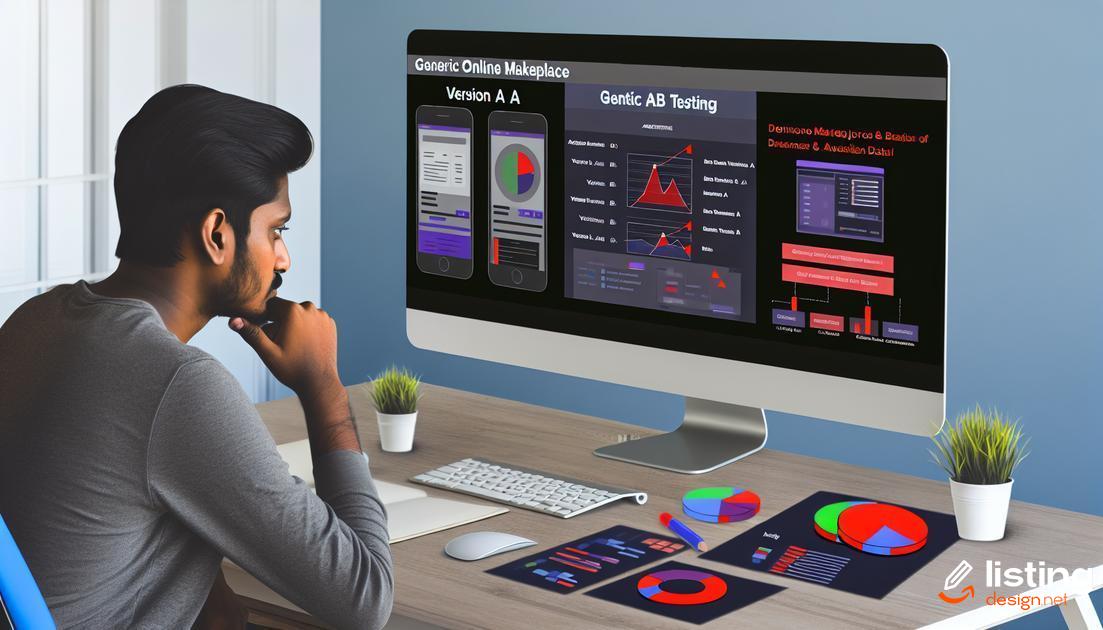When it comes to boosting your Amazon sales, A/B testing is an essential tool. By leveraging A/B testing Amazon strategies, sellers can determine what works best for their audience. This guide will walk you through the basics of A/B testing, from understanding its importance to implementing and analyzing tests effectively. With practical tips and proven strategies, you will be equipped to enhance conversions and stay ahead in the competitive Amazon marketplace.
Table of Contents
Understanding A/B Testing
Understanding A/B testing is crucial for Amazon sellers looking to optimize their listings and increase conversions. A/B testing, also known as split testing, involves comparing two versions of a webpage or product listing to determine which one performs better. By systematically changing elements like titles, images, or descriptions, sellers can gather data on customer preferences and behaviors.
The process starts by creating two versions (A and B) of a single variable while keeping other elements constant. Version A might be the current listing, while version B includes a slight variation, such as a different headline. These versions are then shown to random segments of your audience simultaneously. The performance of each version is measured using metrics such as click-through rates, conversion rates, and sales volume.
This data-driven approach removes guesswork and helps to make informed decisions that maximize the effectiveness of your listings. Over time, continuous A/B testing can lead to significant improvements in how customers perceive value and make purchasing decisions on Amazon.
A/B testing is not a one-time activity but an ongoing strategy. By continually testing and refining elements of your listings, you can adapt to shifting consumer preferences and market trends, ensuring that your Amazon store remains competitive.
Why A/B Testing Matters for Amazon Sellers
A/B testing, or split testing, is a powerful technique that can significantly impact your Amazon sales. By comparing two versions of a product listing to determine which performs better, sellers can make informed decisions to optimize their listings.
One of the primary advantages of A/B testing for Amazon sellers is the ability to enhance conversion rates. By testing different product titles, images, descriptions, and prices, sellers can see which elements resonate most with their target audience. This detailed approach ensures that each change made is backed by data, rather than guesswork.
A/B testing also allows sellers to understand customer preferences and behaviors more intricately. By analyzing the results of these tests, sellers can pinpoint what features or benefits their customers value most, leading to more effective marketing strategies and product positioning.
In the competitive landscape of Amazon, where even small changes can lead to significant sales increases, A/B testing provides a strategic edge. It helps sellers not only to boost conversions but also to gain valuable insights that can inform broader business strategies and objectives.
Basic Steps to Start A/B Testing
- Define Your Objective: Identify what you want to achieve with your A/B test, such as increasing click-through rates or improving conversion rates.
- Choose Your Variables: Decide which elements you want to test. This could be headlines, product descriptions, images, or call-to-action buttons.
Create Your Variations
: Develop different versions of the elements you are testing. Ensure that each variation is distinct enough to provide meaningful results.
- Implement Your Test: Use a reliable A/B testing tool to set up and launch your test. Make sure to split your traffic evenly between the different variations.
- Monitor Performance: Keep an eye on the test as it runs. Look for any immediate trends or unexpected issues that might skew your results.
- Analyze Results: After the test period, analyze the data to see which variation performed best. Look at key metrics like conversion rates, click-through rates, and revenue.
- Make Data-Driven Decisions: Use the insights gained from your A/B test to make informed decisions. Implement the winning variation and consider future tests to continue optimizing.
Tools for Effective A/B Testing on Amazon
Choosing the right tools is critical for executing effective A/B tests on Amazon. Utilizing advanced tools can help streamline the testing process and deliver actionable insights. Here are some top tools to consider:
1. Amazon Experiments
This is Amazon’s built-in A/B testing tool, specifically designed for sellers. It allows you to test different product images, titles, and descriptions to determine what works best.
2. Splitly
Splitly offers automation features that simplify A/B testing for Amazon products. It can test multiple elements, such as pricing and listing content, to help optimize for higher conversions.
3. Optimizely
Although not exclusive to Amazon, Optimizely is a powerful A/B testing tool that enables you to run experiments on your product pages. Its comprehensive analytics can help you understand customer behavior and improve your listings.
4. Seller Labs
This tool provides A/B testing capabilities focused on Amazon products. Seller Labs helps you improve your listings through data-driven changes, aimed at boosting your sales.
Integrating these tools into your A/B testing strategy can lead to significant improvements in your Amazon sales performance. By leveraging their unique features, you can identify the most effective elements to enhance your product listings.
Creating Hypotheses for A/B Testing
Creating strong hypotheses is crucial for successful A/B testing. A hypothesis is an educated guess about what change might improve your results. It should be testable and measurable. Start by identifying a potential issue or opportunity based on data and customer feedback.
Identify Variables
Focus on one variable at a time to isolate changes’ effects. This could be a headline, call-to-action button, or product image. For instance, you might hypothesize that a more descriptive product title will lead to higher conversion rates.
Use Customer Data
Analyze existing customer behavior to inform your hypotheses. Look at search terms, click-through rates, and purchase history. For example, if customers frequently abandon their carts, hypothesize changes in checkout processes.
Formulate Clear Hypotheses
Write your hypotheses clearly and concisely. Use the format: If [specific change], then [expected outcome], because [reasoning]. For example, “If we add customer reviews to the product page, then conversions will increase because customers trust peer feedback.”
Lasting improvements come from continuous testing and iteration. Validate each hypothesis through rigorous A/B testing, and don’t be afraid to test bold changes. The data you gather will be instrumental in refining your strategies and enhancing the customer experience.
Setting Up A/B Tests on Amazon
Configuring Your A/B Tests
To set up A/B tests on Amazon, you first need to access Manage Your Experiments under the Advertising tab. Start by selecting a product that has consistent sales and traffic. Create variations of your product listings: this can involve changing the product title, images, price, or descriptions.
Next, define a clear objective for each test, such as increasing click-through rates or sales conversions. Choose the variables that you’ll test and keep all other factors constant to ensure accurate results. Amazon’s A/B testing tool allows you to run experiments for a pre-determined period, usually 4 to 10 weeks, to gather enough data.
It’s crucial to monitor your tests regularly. Use performance data in real-time to make informed decisions. Detailed reporting features in the Manage Your Experiments dashboard will provide insights on which variations perform better.
Once the test period concludes, analyze the data to identify the winning variation. Implement the winning changes across your product listings to optimize performance. Always consider running new tests to keep improving.
Remember to stay compliant with Amazon’s policies throughout the testing process to avoid any penalties.
Analyzing A/B Test Results
Once your A/B test at Amazon has concluded, the analysis phase begins. This is where you determine if there is a statistically significant difference between your variations. Start by gathering all relevant data and sorting it through key performance indicators (KPIs) like conversion rate, click-through rate, and average order value.
Use visualizations such as charts and graphs to compare the performance of each variant. This will help in identifying trends and differences more clearly.
Statistical Significance
Calculate the statistical significance of your results to ensure they are not due to random chance. Tools such as t-tests can serve this purpose. An outcome is generally considered statistically significant if the p-value is less than 0.05.
It’s also essential to segment your data. Evaluate performance based on various criteria like device type, geolocation, and time of day. This segmentation can provide deeper insights into how different audience segments responded to your test variations.
After interpreting the data, generate detailed reports that highlight both the winning and losing variants, along with recommendations for future tests. Consistently refine your hypotheses and test parameters based on these insights to improve continuously.
Key Metrics to Track in A/B Testing
When conducting A/B tests, tracking the right metrics is crucial for understanding the effectiveness of your variations. Here are some key metrics to focus on:
Conversion Rate (CR)
The primary metric for any A/B test is the conversion rate. It measures the percentage of visitors who complete a desired action, such as making a purchase or signing up for a newsletter.
Click-through Rate (CTR)
CTR is another essential metric. It shows the percentage of visitors who clicked on a specific link or button, helping you gauge the effectiveness of your call-to-action elements.
Average Order Value (AOV)
Tracking AOV helps you understand how much, on average, each customer spends per transaction. A positive change in AOV can indicate a more successful variant.
Bounce Rate
A high bounce rate means visitors are leaving the site quickly. Tracking bounce rates can help identify which variation better retains visitors.
Time on Page
This metric measures how long a visitor spends on your page. More time spent usually indicates better engagement with your content.
Customer Lifetime Value (CLV)
CLV measures the total revenue a business can expect from a single customer account. A higher CLV usually indicates a more loyal and valuable customer base.
Return on Investment (ROI)
Finally, tracking ROI helps you understand the financial implications of your A/B tests. Positive ROI indicates that the benefits outweigh the costs of implementing the changes.
Common Mistakes to Avoid in A/B Testing
Neglecting Sample Size
Ensuring a sufficient sample size is crucial for reliable A/B test results. Inadequate sample sizes can lead to misleading conclusions. Make sure your test runs long enough to gather a statistically significant amount of data.
Ignoring Seasonality Effects
Seasonal trends can heavily influence buyer behavior. Be mindful of the timing when you run your A/B tests to avoid skewed data. Comparing results from different seasons without accounting for these changes can lead to incorrect assumptions.
Testing Too Many Variables at Once
It’s tempting to test multiple variables simultaneously to save time, but this can lead to confusion about which change caused the desired effect. Focus on one variable at a time for clearer insights.
Lack of Clear Hypothesis
One of the most fundamental mistakes to avoid is running A/B tests without a clear hypothesis. Start with a specific question or prediction about what you expect from the test. This will guide your analysis and help in drawing conclusive results.
Not Monitoring Regularly
Regularly check your tests to ensure they are running as expected. Unforeseen issues can arise, such as changes to the platform or user behavior that can affect your results. Regular monitoring helps catch these issues early.
Ignoring Statistical Significance
Always wait for the test to reach statistical significance before drawing any conclusions. Ending tests too early can result in adopting changes that are not truly beneficial. Use tools and calculators to determine the significance level of your results.
Not Segmenting Your Audience
Different segments of your audience may react differently to changes. Segmenting your audience allows for more detailed insights and ensures you cater to all customer groups effectively. This is particularly essential for larger and diverse markets like Amazon.
Case Studies: Successful A/B Tests on Amazon
Successful Price Testing
In one study, an Amazon seller tested different price points for a popular product. By experimenting with variations in price, they could identify the optimal point that maximized both sales and profit margins.
Product Description Optimization
Another case involved optimizing product descriptions. By A/B testing different versions of the product description, the seller was able to improve clarity and appeal, resulting in higher conversion rates.
Image Testing
Visual content is crucial for online sales. One retailer tested various product images and discovered that high-quality, detailed photos significantly increased the click-through rate (CTR) and overall sales.
Review Display Strategies
Displaying customer reviews above the fold versus below the fold was tested by another seller. The results showed a significant boost in conversion rates when reviews were prominently displayed.
Shipping Options
Testing different shipping options and displaying estimated delivery times also proved successful. Customers preferred having more precise delivery information, which in turn increased purchase likelihood. These case studies demonstrate the effective use of A/B testing in various aspects of an Amazon product listing. Each test provided actionable insights that led to optimized conversions and improved overall performance.
Best Practices for Continuous Improvement
Continuous improvement is essential for maintaining a competitive edge on Amazon. Review your A/B tests regularly to ensure that the changes you implement are leading to the desired outcomes. Use data-driven insights to fine-tune your strategies.
Gather customer feedback to identify potential areas for improvement that data alone might not reveal. Engage with reviews, conduct surveys, and analyze comments to get a holistic view of customer preferences and pain points.
Prioritize Incremental Changes
Implement incremental changes rather than sweeping overhauls. Small, consistent adjustments are easier to measure and optimize. They also reduce the risk of negatively impacting your sales performance.
Optimize your listings regularly based on the latest market trends and competitor analysis. Keeping an eye on what works for others can provide inspiration and insight into effective strategies.
Leverage Advanced Analytics
Invest in advanced analytics tools to gain deeper insights into your A/B testing results. These tools can help you understand the nuances of your data and identify trends that might not be immediately apparent.
Establish a continuous feedback loop to ensure that your improvement processes are ongoing. Regularly review your strategies and outcomes to make iterative enhancements to your Amazon listings.
Future Trends in A/B Testing for E-commerce
The future of A/B testing in e-commerce, especially on platforms like Amazon, is evolving rapidly. Innovations are shaping how businesses optimize their strategies to boost conversions. One emerging trend is the integration of Artificial Intelligence (AI). AI can analyze vast amounts of data faster than traditional methods, identifying patterns and providing actionable insights more efficiently.
Another significant trend is the shift towards personalization at scale. Instead of a one-size-fits-all approach, A/B testing is increasingly focusing on tailoring experiences to individual user preferences. This personalized testing allows for more accurate targeting and better customer satisfaction.
Additionally, the rise of real-time analytics is transforming A/B testing. Real-time data enables businesses to adjust their strategies on the fly, leading to quicker optimizations and more agile marketing campaigns. This is crucial for staying competitive in the fast-paced e-commerce landscape.
Moreover, the use of multivariate testing is becoming more common. This method tests multiple variables simultaneously, providing deeper insights into how different elements interact with each other. It allows for more complex experimentation and optimization of various parts of a webpage or app simultaneously.
Finally, enhanced automation tools are streamlining the A/B testing process. These tools reduce manual effort and minimize the margin for error, making it easier for businesses to conduct thorough and frequent tests. Automation also facilitates continuous improvement, allowing for constant iteration and refinement of strategies.








